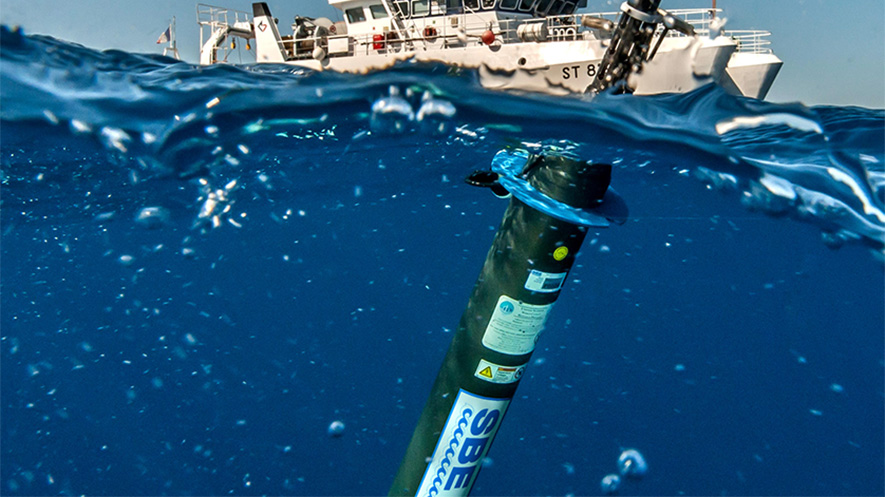Sea-Bird Scientific has provided a preview of the science program they have put together for the upcoming Ocean Sciences Meeting to be held in Portland, Oregon from Feb 12-16.
The Ocean Sciences Meeting has always been a very important event for the greater oceanographic community, as it provides a valuable opportunity to meet, hear about the latest scientific research, and discuss current oceanographic trends and implications for future exploration. Sea-Bird Scientific has provided brief previews of the posters and talks their science team will be presenting at the meeting:
Dynamic corrections for Sea-Bird Surface Temperature Salinity Sensors (STS) on ARGO profiling floats
Kim Martini, Ph.D., Senior Oceanographer, David J. Murphy, MS, Director of Research and Development, Raymond W. Schmitt, and Nordeen G. Larson
The Surface Temperature Salinity Sensor (STS) is a CTD that extends temperature and salinity measurements through the sea surface on ARGO profiling floats , providing ground truth for satellites and determining meteorological heat and water fluxes. Unlike the primary conductivity sensor on the profiling float, the STS conductivity cell is freely-flushed, which presents additional challenges in data processing to achieve accurate salinities.
Sea-Bird Scientific has determined performance characteristics and dynamic corrections for the STS sensor from experiments performed in a stratified tank. They will discuss the functional characteristics of the STS sensor, guiding the analysis and the best practices for applying these corrections in situ.
Field Validation of ISFET based Ocean pH Sensors
Charles W. Branham, Ph.D., Senior Chemist and David J. Murphy, MS, Director of Research and Development
Continuous and reliable pH measurements in the ocean remain one of the key challenges facing researchers studying ocean acidification. Commonly used glass bulb pH sensing technology is subject to rapid calibration drift, making it unfit for long-term autonomous deployments. Thus, the need for a robust pH sensor is crucial to understanding our changing seas.
Sea-Bird Scientific pH sensors were developed to meet this need. Based on Honeywell's industrial Durafet pH sensor technology and packaged in a depth tolerant housing, their sensors have demonstrated that they can maintain accuracy for long-term deployments while withstanding harsh conditions. This presentation will focus on calibration of the ISFET pH sensor, evaluate its analytical performance, and validate performance of new pH sensor models using recent field data.
Determination of Conductivity Cell Compressibility for Argo Program CTDs and MicroCATs
David J. Murphy, MS, Director of Research and Development and Kim Martini, Ph.D., Senior Oceanographer
Measuring conductivity in the deep ocean (below 1000 meters) requires a correction for the compressibility of the conductivity cell, which depends on the material that encapsulates the conductivity cell.
Sea-Bird Scientific applies a nominal compressibility correction term measured from conductivity cells manufactured with an epoxy encapsulation material. As part of the development effort for Argo program CTDs and MicroCAT products, Sea-Bird changed the conductivity cell encapsulation material from epoxy to urethane. This change in material necessitates a new compressibility correction. This work uses data from deployments of Deep Argo CTDs and conductivity calculated from discrete salinity samples to derive the pressure compressibility correction term for a urethane encapsulated conductivity cell. We will verify prior work done to determine the nominal coefficient used for epoxy encapsulated conductivity cells and propose a coefficient for urethane encapsulated cells that will improve the accuracy of conductivity measured in the deep ocean.
Measuring Calibration and Field Variance Scales in Oceanographic Optical Instrumentation Data for Quality Assurance
Ian Walsh, Ph.D., Director of Science
Metrics that test an instrument's current data against previous data are fundamental to real time quality assurance. For oceanographic instrumentation, especially instruments deployed on remote and autonomous platforms, the operator rarely has the luxury of periodically examining the instrument to test its current state relative to the pre- and post-deployment states.
For remote instruments that report their data in real time or are never intended to be recovered, the instrument's data stream is the only information available to assess data quality. As such, quality metrics must compare field data variance to baseline data from controlled conditions. Often, the instrument's original calibration data is a logical choice for quantifying baseline data.
In this study, Sea-Bird Scientific compares signal variances for a suite of instruments that measure optical backscattering and fluorescence. They compare a new instrument design across a variety of controlled environments with instruments that have a much longer pedigree, and they control for data delivery rate and internal averaging to demonstrate the relationship of variance to common use cases, such as when power and data bandwidth limit data rates. They then compare the controlled environment data with field data from a tidally driven environment to demonstrate real-time QA/QC methods.
More Science from the 2018 Ocean Sciences Meeting
The full scientific program for the 2018 Ocean Sciences Meeting is searchable online. To search, click on the search button at the top, right-hand corner of the online program. Click on “Advanced Search” to search by session, paper, person, primary topic or other criteria. To browse all sessions, click on the Primary Topic link on the left-hand side of the search engine. Scientific, education and policy sessions will cover wide-ranging topics such as ocean-land connections, renewable energy, climate change, marine biodiversity and more.
About the 2018 Ocean Sciences Meeting
The 2018 Ocean Sciences Meeting (OSM), co-sponsored by the American Geophysical Union (AGU), the Association for the Sciences of Limnology and Oceanography (ASLO), and The Oceanography Society (TOS), will be held 11–16 February, in Portland, Oregon. The OSM is an important venue for scientific exchange across broad marine science disciplines. Sessions will include all aspects of oceanography, especially multidisciplinary topics, as well as presentations that reflect new and emerging research on the global ocean and society, including science education, outreach, and public policy. The OSM originated in 1982 as a joint effort between AGU and ASLO; TOS joined as a regular co-sponsor in 2004.






